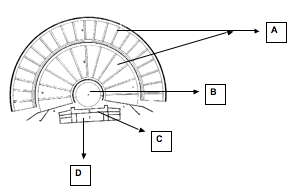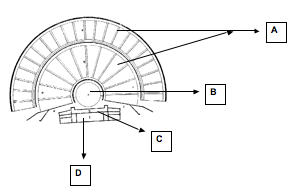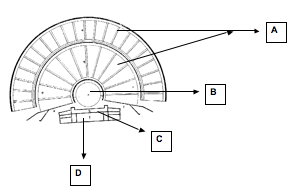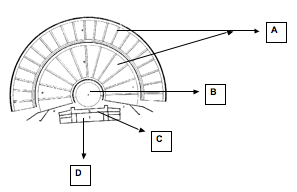Repaso - OrĂgenes Del Teatro

- 1.
El Teatro naciĂł en
- A.
Italia
- B.
Grecia
- C.
Francia
- D.
España
Correct Answer
B. GreciaExplanation
The correct answer is Grecia because ancient Greece is widely recognized as the birthplace of theater. The Greeks developed and established many of the fundamental elements of theater, including the use of actors, scripts, and performances in dedicated spaces. Greek theater had a significant impact on the development of drama and performance arts in subsequent civilizations, making Greece the most appropriate answer in this context.Rate this question:
-
- 2.
Dionisio era para los griegos el dios de
- A.
La guerra y el mar
- B.
Las fiestas y la sabidurĂa
- C.
El vino y la fertilidad
- D.
El amor y la familia
Correct Answer
C. El vino y la fertilidadExplanation
Dionisio era conocido por ser el dios del vino y la fertilidad. En la mitologĂa griega, se le asociaba con la celebraciĂłn de fiestas y festivales, donde se consumĂa vino en abundancia. Además, se le consideraba un dios que favorecĂa la fertilidad en la naturaleza y en los seres vivos. Por lo tanto, la respuesta correcta es "el vino y la fertilidad".Rate this question:
-
- 3.
Las festividades que se hacĂan en honor a Dionisio se llamaban
- A.
Dionisiacas
- B.
Dionisidios
- C.
DiĂłnadas
- D.
Diofiestas
Correct Answer
A. DionisiacasExplanation
Las festividades que se hacĂan en honor a Dionisio se llamaban "Dionisiacas" porque Dionisio era el dios griego del vino y las festividades en su honor solĂan estar relacionadas con la celebraciĂłn y consumo de vino. "Dionisiacas" es el tĂ©rmino correcto para referirse a estas festividades especĂficas.Rate this question:
-
- 4.
En las festividades en honor a Dionisio se instituyĂł un certamen para
- A.
La mejor tĂşnica
- B.
El mejor actor
- C.
El mejor coro
- D.
La mejor tragedia
Correct Answer
D. La mejor tragediaExplanation
During the festivities in honor of Dionysus, a competition was established to determine the best tragedy. This suggests that in these celebrations, there was a focus on theatrical performances, particularly tragedies. Participants would showcase their skills in writing and performing tragic plays, and the winner would be awarded the title of having the best tragedy. This competition highlights the importance of tragedy in the cultural and artistic context of the festivities dedicated to Dionysus.Rate this question:
-
- 5.
El primer actor del que se tiene conocimiento fue
- A.
AristĂłfanes
- B.
EurĂpides
- C.
Thespis
- D.
SĂłfocles
Correct Answer
C. ThespisExplanation
Thespis is considered the first actor in recorded history. He was a Greek poet who introduced the concept of an individual actor separate from the chorus in ancient Greek theater. Thespis is credited with innovating the art of acting by stepping out of the chorus and performing solo, thus laying the foundation for the development of theater as we know it today. His contributions to drama and the performing arts are significant, making him the correct answer to the question.Rate this question:
-
- 6.
La comedia naciĂł en
- A.
Las calles por la gente que se burlaba de las obras trágicas
- B.
Grecia por los actores que perdĂan en los certámenes de tragedia
- C.
En los teatros por iniciativa del coro
- D.
Las calles por grupos de borrachos que improvisaban
Correct Answer
D. Las calles por grupos de borrachos que improvisabanExplanation
The correct answer is "las calles por grupos de borrachos que improvisaban". This answer suggests that comedy originated in the streets, specifically by groups of drunk people who would improvise comedic performances. This explanation aligns with the historical context of comedy being associated with informal, spontaneous performances in contrast to the more structured and serious nature of tragic plays.Rate this question:
-
- 7.
Las primeras obras se hicieron con
- A.
1 actor
- B.
7 actores
- C.
10 actores
- D.
3 actrices
Correct Answer
A. 1 actorExplanation
The correct answer is "1 actor" because the question is asking about the number of actors involved in the first works. The phrase "Las primeras obras" translates to "The first works" in English. Since the question only mentions the number of actors and not actresses, we can infer that the first works were performed by only one actor.Rate this question:
-
- 8.
Para la Ă©poca de los OrĂgenes del Teatro
- A.
SĂłlo las mujeres podĂan actuar
- B.
Actuaban los hombres y las mujeres
- C.
Actuaban los niños más inteligentes de la ciudad
- D.
SĂłlo los hombres podĂan actuar
Correct Answer
D. SĂłlo los hombres podĂan actuarExplanation
During the Origins of Theater, only men were allowed to act. This was a common practice in ancient times, where women were often excluded from participating in public performances. The roles of female characters were played by men, as it was believed that women were not suitable for such activities. Therefore, the statement "sĂłlo los hombres podĂan actuar" is the correct answer.Rate this question:
-
- 9.
Para cambiar de un personaje a otro...
- A.
Cambiaban de tĂşnica larga a corta
- B.
Cambiaban de máscara
- C.
Cambiaban de color de tĂşnica
- D.
Cambiaban de máscara con el otro actor
Correct Answer
B. Cambiaban de máscaraExplanation
The correct answer is "cambiaban de máscara". This means that they would change masks in order to switch from one character to another. This suggests that the characters in question were likely wearing masks as part of their costumes, and by changing masks, they were able to transform into different characters.Rate this question:
-
- 10.
Las máscaras se hacĂan con
- A.
Madera liviana y corcho
- B.
Con corcho y metal
- C.
Madera liviana y semillas
- D.
Metal y semillas
Correct Answer
A. Madera liviana y corchoExplanation
Las máscaras se hacĂan con madera liviana y corcho porque ambos materiales son fáciles de tallar y moldear, lo que permite crear diseños detallados y realistas en las máscaras. La madera liviana proporciona una base sĂłlida y duradera para la máscara, mientras que el corcho se utiliza para agregar detalles y texturas. Esta combinaciĂłn de materiales permite a los artesanos crear máscaras ligeras y cĂłmodas de usar, al tiempo que les brinda la flexibilidad necesaria para crear diferentes estilos y formas.Rate this question:
-
- 11.
Las máscaras tenĂan la boca en forma de megáfono para
- A.
Para que se viera mejor la expresiĂłn de la boca del actor
- B.
Para que pudieran ver por allĂ
- C.
Para amplificar el volumen de la voz de los actores de forma natural
- D.
Para acomodarle el micrĂłfono y que el pĂşblico no lo viera
Correct Answer
C. Para amplificar el volumen de la voz de los actores de forma naturalExplanation
The masks had a mouth shaped like a megaphone in order to naturally amplify the volume of the actors' voices. This would allow their voices to be heard better by the audience without the need for artificial amplification.Rate this question:
-
- 12.
El coro
- A.
HacĂa comentarios sobre la acciĂłn, dialogaba con los personajes, narraba parte de la historia
- B.
Danzaba y cantaba en lo que el pĂşblico se acomodaba en sus asientos
- C.
HacĂa un resumen al final de la obra de todo lo que habĂa ocurrido
- D.
EntretenĂa al pĂşblico con chistes antes de que empezara la obra
Correct Answer
A. HacĂa comentarios sobre la acciĂłn, dialogaba con los personajes, narraba parte de la historiaExplanation
The correct answer is "hacĂa comentarios sobre la acciĂłn, dialogaba con los personajes, narraba parte de la historia." This answer accurately describes the role of the chorus in the context of the given information. The chorus not only comments on the action and interacts with the characters, but also helps narrate the story.Rate this question:
-
- 13.
El coro
- A.
Inicialmente era de 12 personas
- B.
Siempre fue de 50 personas
- C.
Era formado por voluntarios del pĂşblico por lo que el nĂşmero variaba
- D.
Era de entre 20 a 25 personas
Correct Answer
A. Inicialmente era de 12 personasExplanation
The correct answer is "inicialmente era de 12 personas". This means that initially, the choir consisted of 12 people. This suggests that the size of the choir may have changed over time, but at the beginning, it had only 12 members.Rate this question:
-
- 14.
Las máscaras del coro
- A.
Eran con rasgos femeninos
- B.
Eran todas iguales con cuernos de cabra
- C.
TenĂan diferentes tipos de cuernos de diferentes animales
- D.
Eran con rasgos de personas ancianas, sĂmbolo de la sabidurĂa
Correct Answer
B. Eran todas iguales con cuernos de cabraExplanation
The correct answer is "eran todas iguales con cuernos de cabra" which means "they were all the same with goat horns." This suggests that the masks in the choir all had the same design, featuring goat horns.Rate this question:
-
- 15.
Las tĂşnicas eran
- A.
Las almohadillas que utilizaban para rellenar el vestuario
- B.
El vestuario que se ponĂan los actores para representar sus personajes
- C.
El nombre que se le daba a las máscaras
- D.
Las sandalias que se ponĂan los actores
Correct Answer
B. El vestuario que se ponĂan los actores para representar sus personajesExplanation
The correct answer is "el vestuario que se ponĂan los actores para representar sus personajes." This answer explains that "las tĂşnicas" were the costumes that actors used to wear in order to portray their characters.Rate this question:
-
- 16.
Las tĂşnicas que usaban para las tragedias era
- A.
Rojas
- B.
Cortas
- C.
Largas
- D.
Con colores oscuros
Correct Answer
C. LargasExplanation
The correct answer is "largas" because the sentence states that the tunics used for tragedies were "largas" which means long in English.Rate this question:
-
- 17.
Las tĂşnicas de las comedias eran
- A.
Rojas
- B.
Cortas
- C.
Largas
- D.
Con colores oscuros
Correct Answer
B. CortasExplanation
Las tĂşnicas de las comedias eran cortas.Rate this question:
-
- 18.
Los coturnos eran
- A.
Los sujetadores para poder mantener las máscaras en su lugar
- B.
Los objetos que utilizaban los actores
- C.
Los adornos que le ponĂan a las tĂşnicas
- D.
Los zapatos de plataforma alta y liviana que utilizaban para actuar
Correct Answer
D. Los zapatos de plataforma alta y liviana que utilizaban para actuarExplanation
The correct answer is "los zapatos de plataforma alta y liviana que utilizaban para actuar" because the word "coturnos" refers to high and lightweight platform shoes that were worn by actors during performances. These shoes not only provided height to the actors but also helped them portray their characters more effectively on stage.Rate this question:
-
- 19.
Los teatros griegos eran iluminados
- A.
Con fuego
- B.
Con las linternas que llevaba el pĂşblico
- C.
Con potentes instrumentos de iluminaciĂłn
- D.
Por la luz solar
Correct Answer
D. Por la luz solarExplanation
Los teatros griegos eran iluminados por la luz solar. Durante las representaciones teatrales en la antigua Grecia, los teatros estaban diseñados de tal manera que aprovechaban al máximo la luz natural del sol. Los teatros tenĂan una ubicaciĂłn estratĂ©gica en la ladera de una colina para recibir la mayor cantidad de luz solar posible. Además, se utilizaban elementos arquitectĂłnicos, como la inclinaciĂłn de los asientos y la disposiciĂłn de los edificios circundantes, para reflejar y amplificar la luz solar en el escenario. De esta manera, la luz solar proporcionaba la iluminaciĂłn necesaria para las actuaciones teatrales.Rate this question:
-
- 20.
Eran muchos los que querĂan ir a ver las obras asĂ que
- A.
Presentaban la misma obra durante todo el año
- B.
Dejaron de presentar las obras para evitar los motines
- C.
Tuvieron que introducir los derechos de entrada y los boletos
- D.
SĂłlo podĂan verla los primeros en llegar al teatro
Correct Answer
C. Tuvieron que introducir los derechos de entrada y los boletosExplanation
The correct answer is "tuvo que introducir los derechos de entrada y los boletos". This means that they had to introduce entrance fees and tickets. This suggests that there were a lot of people who wanted to see the plays, so in order to manage the demand and avoid chaos, they implemented a system of charging for entry and issuing tickets. This would help control the number of people attending the shows and ensure a fair distribution of seats.Rate this question:
-
- 21.
El término Teatro proviene del la palabra theatron que significa
- A.
Hablar
- B.
Danzar
- C.
Actuar
- D.
Mirar
Correct Answer
D. MirarExplanation
The term "Teatro" comes from the word "theatron" which means "to watch" or "to observe". In the context of theater, "mirar" refers to the act of watching a performance or observing the actors on stage. Therefore, "mirar" is the correct answer as it accurately reflects the meaning of the word "theatron" and its relation to theater.Rate this question:
-
- 22.
Este es el diagrama del Teatro Griego (vista aérea). La parte del teatro identificada con la letra A corresponde a:
- A.
Skene
- B.
Proskenio
- C.
Orchestra
- D.
Theatron
Correct Answer
D. TheatronExplanation
The correct answer is Theatron. In a Greek theater, the Theatron is the seating area where the audience sits to watch the performances. It is the largest part of the theater and is typically semicircular in shape. The Skene is the building behind the stage where actors would change costumes, the Proskenio is the stage itself, and the Orchestra is the circular area in front of the stage where the chorus would perform.Rate this question:
-
- 23.
Este es el diagrama del Teatro Griego (vista aérea). La parte del teatro identificada con la letra B corresponde a:
- A.
Skene
- B.
Proskenio
- C.
Orchestra
- D.
Theatron
Correct Answer
C. OrchestraExplanation
The correct answer is Orchestra. In a Greek theater, the orchestra refers to the circular or semicircular area at the center of the theater where the chorus would perform and the actors would interact with them. The skene is the building behind the orchestra where the actors would change costumes and the proskenio is the front part of the skene where the actors would perform. The theatron refers to the seating area for the audience.Rate this question:
-
- 24.
Este es el diagrama del Teatro Griego (vista aérea). La parte del teatro identificada con la letra C corresponde a:
- A.
Skene
- B.
Proskenio
- C.
Orchestra
- D.
Theatron
Correct Answer
B. ProskenioExplanation
The correct answer is Proskenio. In a Greek theater, the proskenio refers to the stage area located in front of the skene. It is a raised platform where the actors would perform their scenes. The skene, on the other hand, is the building behind the stage that served as a backdrop for the performances. The orchestra is the circular area in front of the stage where the chorus would sing and dance, and the theatron refers to the seating area for the audience.Rate this question:
-
- 25.
Este es el diagrama del Teatro Griego (vista aérea). La parte del teatro identificada con la letra D corresponde a:
- A.
Skene
- B.
Proskenio
- C.
Orchestra
- D.
Theatron
Correct Answer
A. SkeneExplanation
The correct answer is Skene. In Greek theater, the skene was a building located behind the orchestra where actors would change costumes and masks. It served as a backdrop for the performances and often had multiple doors for the actors to enter and exit the stage. The skene was an important architectural element in Greek theater and played a significant role in the overall production.Rate this question:
-
- 26.
El theatron era la parte del teatro que se utilizaba
- A.
Como decorado de fondo y camerino para los actores
- B.
Como escenario para los actores
- C.
Para que el coro danzara
- D.
Para acomodar al pĂşblico
Correct Answer
D. Para acomodar al pĂşblicoExplanation
The correct answer is "para acomodar al pĂşblico". This is because "el theatron" refers to the seating area or auditorium in a theater where the audience is accommodated. It is the part of the theater that is specifically designed and used to provide seating for the public or spectators.Rate this question:
-
- 27.
La orchestra era la parte del teatro que se utilizaba
- A.
Como decorado de fondo y camerino para los actores
- B.
Como escenario para los actores
- C.
Para que el coro danzara
- D.
Para acomodar al pĂşblico
Correct Answer
C. Para que el coro danzaraExplanation
The correct answer is "para que el coro danzara" which means "for the choir to dance." This suggests that the orchestra was used to provide musical accompaniment for the choir's dancing.Rate this question:
-
- 28.
El proskenio era la parte del teatro que se utilizaba
- A.
Como decorado de fondo y camerino para los actores
- B.
Como escenario para los actores
- C.
Para que el coro danzara
- D.
Para acomodar al pĂşblico
Correct Answer
B. Como escenario para los actoresExplanation
The correct answer is "como escenario para los actores" which means "as a stage for the actors" in English. The proskenio was the part of the theater that was used as the stage where the actors performed their scenes. It was the main area where the actors would act out their roles and interact with each other.Rate this question:
-
- 29.
El skene era la parte del teatro que se utilizaba
- A.
Como decorado de fondo y camerino para los actores
- B.
Como escenario para los actores
- C.
Para que el coro danzara
- D.
Para acomodar al pĂşblico
Correct Answer
A. Como decorado de fondo y camerino para los actoresExplanation
The skene was used as a backdrop and dressing room for the actors. It served as a place where the actors could change costumes and prepare for their performances. Additionally, it provided a scenic background for the play, enhancing the visual experience for the audience.Rate this question:
-
- 30.
En los orĂgenes del teatro, Edipo Rey fue
- A.
La comedia más importante de esa época
- B.
El actor más importante de esa época
- C.
Una de las obras trágicas más importante de esa época
- D.
El dramaturgo más importante de esa época
Correct Answer
C. Una de las obras trágicas más importante de esa épocaExplanation
Edipo Rey fue una de las obras trágicas más importante de esa Ă©poca. Esta respuesta se basa en el hecho de que Edipo Rey es una tragedia griega escrita por SĂłfocles en el siglo V a.C. y es considerada una de las obras más importantes de la literatura antigua. La obra trata sobre el destino trágico de Edipo, quien sin saberlo mata a su padre y se casa con su madre, lo que lleva a su propia destrucciĂłn. Su importancia radica en su influencia en el desarrollo del gĂ©nero trágico y en su exploraciĂłn de temas universales como el destino, el libre albedrĂo y la naturaleza humana.Rate this question:
-
- 31.
Cuando el coro perdiĂł importancia
- A.
Se redujo la orchestra y se agrandĂł al proskenio
- B.
Se eliminĂł por completo la orchestra
- C.
Se agrandĂł la orchestra y se redujo el proskenio
- D.
Se agrandĂł la orchestra
Correct Answer
A. Se redujo la orchestra y se agrandĂł al proskenioExplanation
Cuando el coro perdió importancia, se redujo la orquesta y se agrandó el proskenio. Esto implica que, debido a la disminución de la importancia del coro, se tomó la decisión de reducir el tamaño de la orquesta y aumentar el tamaño del proskenio. El proskenio es una plataforma elevada en un teatro griego antiguo donde se llevaban a cabo las actuaciones. Esta respuesta indica que se realizaron cambios en la configuración del escenario y la orquesta en respuesta a la disminución de la importancia del coro.Rate this question:
-
- 32.
Durante los orĂgenes del teatro las obras
- A.
Eran muy extensas, se presentaban durante la noche
- B.
Eran muy extensas, se presentaban desde temprano en la mañana
- C.
Eran cortas, se presentaban muchas veces al dĂa
- D.
Eran cortas, se presentaban durante la noche
Correct Answer
B. Eran muy extensas, se presentaban desde temprano en la mañanaExplanation
During the origins of theater, the plays were very long and were presented early in the morning.Rate this question:
-
- 33.
Las máscaras, sĂmbolo universal del teatro, provienen de los orĂgenes del teatro y simbolizan...
- A.
Las emociones que se transmiten al pĂşblico durante una obra
- B.
La alegrĂa y la tristeza
- C.
El drama y la comedia
- D.
La tragedia y comedia
Correct Answer
D. La tragedia y comediaExplanation
Las máscaras en el teatro simbolizan tanto la tragedia como la comedia. Estas dos emociones opuestas son representativas de las experiencias humanas y son elementos clave en la narrativa teatral. La tragedia se refiere a situaciones o eventos trágicos que evocan emociones como el sufrimiento y la tristeza, mientras que la comedia se centra en situaciones humorĂsticas y divertidas que generan risa y alegrĂa. Las máscaras son un sĂmbolo universal del teatro porque representan la dualidad de estas emociones y su capacidad para transmitirse al pĂşblico durante una obra.Rate this question:
-
- 34.
Durante los orĂgenes del teatro
- A.
Todo los que asistĂan tenĂan que pagar
- B.
Pagaban los que podĂan, a los pobres el estado le daba el boleto
- C.
Nunca se cobrĂł por la entrada
- D.
Los ricos pagaban el boleto de los pobres
Correct Answer
B. Pagaban los que podĂan, a los pobres el estado le daba el boletoExplanation
During the origins of theater, everyone who attended had to pay. Those who could afford it paid, while the state provided tickets to the poor. There was never a charge for entry, and the rich paid for the tickets of the poor.Rate this question:
-
- 35.
Los costos de la obra los pagaban
- A.
Los dramaturgos que deseaban ver sus obras representadas
- B.
El pĂşblico hacĂa una recolecta
- C.
Los mismos actores
- D.
Los ciudadanos adinerados
Correct Answer
D. Los ciudadanos adineradosExplanation
The correct answer is "los ciudadanos adinerados" because it states that the wealthy citizens were the ones who paid for the costs of the play. This implies that they were the ones who financially supported the production of the plays in order to have them performed.Rate this question:
-
Quiz Review Timeline +
Our quizzes are rigorously reviewed, monitored and continuously updated by our expert board to maintain accuracy, relevance, and timeliness.
-
Current Version
-
Mar 21, 2023Quiz Edited by
ProProfs Editorial Team -
Sep 12, 2010Quiz Created by
Jseteatro
 Back to top
Back to top






